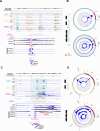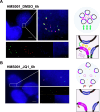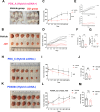This is a preprint.
Inhibition of novel human-HPV hybrid ecDNA enhancers reduces oncogene expression and tumor growth in oropharyngeal cancer
- PMID: 39281879
- PMCID: PMC11398563
- DOI: 10.21203/rs.3.rs-4636308/v1
Inhibition of novel human-HPV hybrid ecDNA enhancers reduces oncogene expression and tumor growth in oropharyngeal cancer
Update in
-
Inhibition of human-HPV hybrid ecDNA enhancers reduces oncogene expression and tumor growth in oropharyngeal cancer.Nat Commun. 2025 Mar 26;16(1):2964. doi: 10.1038/s41467-025-57447-9. Nat Commun. 2025. PMID: 40140353 Free PMC article.
Abstract
Extrachromosomal circular DNA (ecDNA) have been found in most types of human cancers, and ecDNA incorporating viral genomes has recently been described, specifically in human papillomavirus (HPV)-mediated oropharyngeal cancer (OPC). However, the molecular mechanisms of human-viral hybrid ecDNA (hybrid ecDNA) for carcinogenesis remains elusive. We characterized the epigenetic status of hybrid ecDNA using HPVOPC cell lines and patient-derived tumor xenografts, identifying HPV oncogenes E6/E7 in hybrid ecDNA were flanked by novel somatic DNA enhancers and HPV L1 enhancers, with strong cis-interaction. Targeting of these enhancers by clustered regularly interspaced short palindromic repeats interference or hybrid ecDNA by bromodomain and extra-terminal inhibitor reduced E6/E7 expression, and significantly inhibited in vitro and/or in vivo growth only in ecDNA(+) models. HPV DNA in hybrid ecDNA structures are associated with novel somatic and HPV enhancers in hybrid ecDNA that drive HPV ongogene expression and carcinogenesis, and can be targeted with ecDNA disrupting therapeutics.
Conflict of interest statement
Conflict of interest: P.S.M. is a co-founder, chairs the scientific advisory board (SAB) of and has equity interest in Boundless Bio Inc. (BBI). P.S.M. is also an advisor with equity for Asteroid Therapeutics and is an advisor to Sage Therapeutics. V.B. is a co-founder, consultant, SAB member and has equity interest in Boundless Bio and Abterra. J.T.L is an employee of BBI. J.L. previously consulted for BBI. The other authors have no conflicts of interest to disclose.
Figures







References
Publication types
Grants and funding
LinkOut - more resources
Full Text Sources

